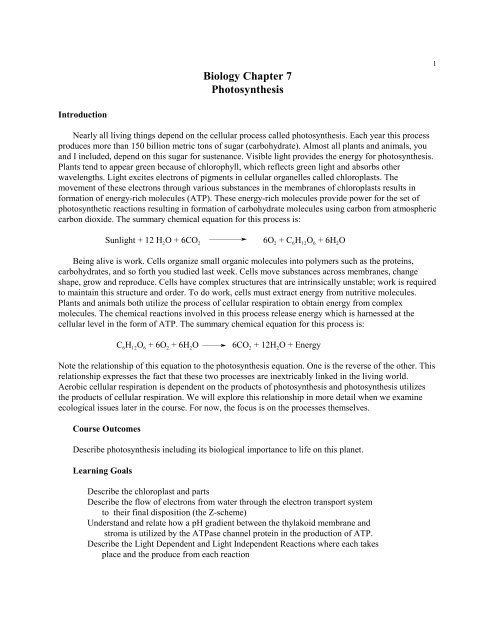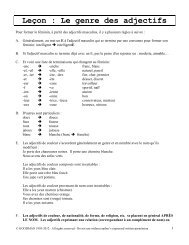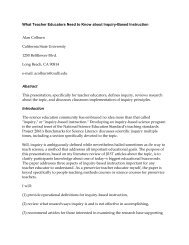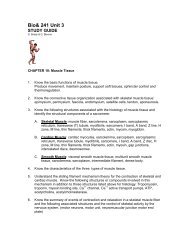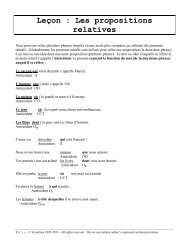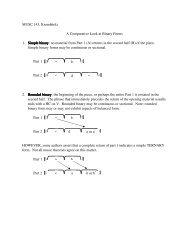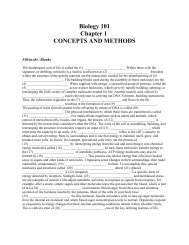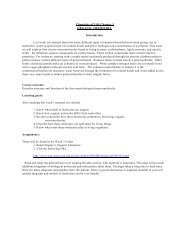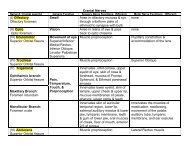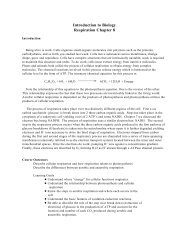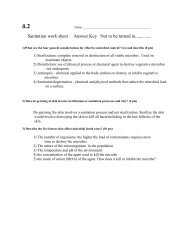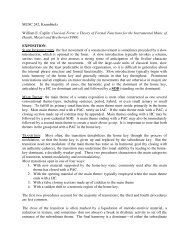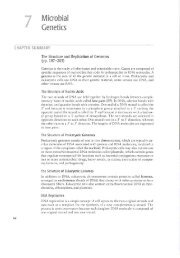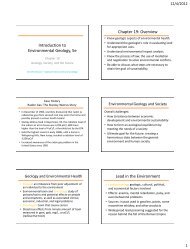Biology Chapter 7 Photosynthesis
Biology Chapter 7 Photosynthesis
Biology Chapter 7 Photosynthesis
Create successful ePaper yourself
Turn your PDF publications into a flip-book with our unique Google optimized e-Paper software.
Assignments:21. Go to the following Web site:http://photoscience.la.asu.edu/photosyn/study.htmlThis is an essay on the importance of photosynthesis. Read this to get a sense of the many ways weare dependent on this process.2. Go to the following Web site:http://www.emc.maricopa.edu/faculty/farabee/BIOBK/BioBookPS.htmlI. <strong>Photosynthesis</strong>A. Energy and materials for the reaction1. The light-dependent reaction (Rxn) converts light energy to chemical energy(which is then stored in ATP)+ +a. Liberated electrons and protons (H ) from water are picked up by NADP2. The light-independent Rxn assemble sugars and other organic moleculesa. Using ATP, NAPDH and CO 23. Overall for Rxn for the synthesis of sugar:B. Where the Rxn takes placeH2O + CO 2 6O 2 + C6H12O61. The two stages of photosynthesis take place in the chloroplast2. Light dependent Rxn occur in the thylakoid membrane systema. The thylakoids are folded into grana (stacks of disks) with channels.b. The interior spaces or lumen of the thylakoid disks and channels arecontinuous.3. Carbohydrate formation occurs in the stroma (semifluid) area thatsurrounds the granaII. Light-Trapping pigmentsA. Light energy is packaged as photons, which vary in energy as a function of wavelength
1. Plants use only a small range (400 - 750 nm) of wavelength for photosynthesis32. Most of these wave lengths are the ones we see as visible colorsB. Pigments absorb light energy and give up electrons1. Chlorophyll pigments absorb blue and reda. Reflect green (the color of leaves).2. Carotenoid pigments absorb violet and bluea. Reflect yellow, orange, and red.III. Light-dependent RxnA. Three event occur:1. Pigments absorb sun light energy and give up electrons2. The pigments that gave up the electrons in the first place get electron replacements3. Electron and hydrogen transfers from water leads to ATP and NADPH formationB. Photosystems1. A photosystem is a cluster of 200 to 300 light-absorbing pigmentslocated in the thylakoid2. The pigments ‘harvest’ sunlighta. Absorbed photons of energy boost electrons to a higher energy levellb. The electrons quickly return to the lower level and release energyc. Released energy is trapped by chlorophylls, which act as a sink for energy harvestedby all pigmentsd. The trapped energy is then used to transfer a chlorophyll electron to an acceptor moleculeC. ATP and NADPH loading up energy, hydrogen and electrons1. Electron transport system are organized in a sequences of enzymes and other proteinsbound in thylakoid membranea. Electrons extracted from H2O by the chlorophyll molecule pass through one or twoelectron transport systems in the thylakoid membrane to produce NADPH from NADP ++b. The flow of H through the thylakoid membrane drives the formation of ATP
42. Cyclic pathway - photosystem I onlya. In the cyclic pathway of ATP formation, electrons are first excited, pass through andelectron transport system, and then return to the original photo-systemb. The cyclic pathway is an ancient way to make ATP from ADP; used by early bacteria.3. Noncyclic pathway -- photosystem IIa. The noncyclic pathway of ATP formation transfers electrons through two photosystemsand two electron transport systems in the thylakoid membranesb. The pathway begins when photosystem II absorbs energy splitting water to harvest electronsand hydrogen releasing O 21) Boosted electron moves through a transport system that releases energy fromADP + PiATP2) An electron fills “hole” left by an electron in photosystem Ic. Pathway continues when Photosystm I absorbs sun light energy1) Energy hole is filled by electron from photosystm II2) Boosted electron from Photosystem I passes to acceptor, through the electron+transport system and finally the electron joins NADP to form NADPH (which alongwith ATP can be used in the synthesis of organic compounds)D. Oxygen1. Oxygen is a by product of the noncyclic pathwayIV. Dark (Light-Independent) RxnA. Overview1. The participants and their roles in the synthesis of carbohydrate area. ATP, which provides energyb. NADPH, which provides hydrogen atoms and electronsc. Atmospheric air, which provides the carbon and oxygen from carbon dioxide.2. These reactions are not dependent on sunlight directly (hence, light independent reaction)
B. Capturing carbon51. Carbon dioxide diffuses from the air through the leaf’s stomates, across theplasma membrane of the plant cell, and into the stroma.2. Carbon fixation occurs when CO 2 becomes attached to ribulose bisphosphate (RuBP) toform a six-carbon intermediate.C. Building the Glucose subunits1. The attachement of CO to RuBP is the first step in the cyclic Calvin-Benson pathway:2a. The six-carbon intermediate, an unstable produce, splits at once to form two PGA(phosphoglycerate) molecules+b. Each PGA then receives a phosphate from ATP plus H and electrons from NADPH toform PGAL (phosphoglyceraldehyde)c. Most of the PGAL molecules continue in the cycle to fix more carbon dioxide but twoPGAL join to form a sugar phophate, which will be modified to sucrose, starch andcellulose2. Final PRODUCTH O + CO + ATP + NADPHC H O + ADP + Pi + NADP + H O + H+ +2 2 6 12 6 2


